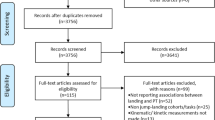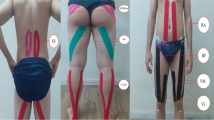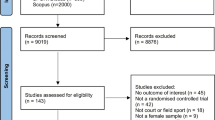Abstract
Background
Lower extremity overuse injuries are common in athletes participating in sports with repeated bouts of landing manoeuvres. Biomechanical alterations during landing may be associated with these types of injuries. The objective of this systematic review with meta-analysis was to summarise and determine the relationship between kinematic alterations during a landing task and the development of lower extremity overuse injuries in physically active populations.
Methods
PubMed, Embase, Web of Science, CINAHL, and SPORTDiscus were consulted up to and including February 2020. Cohort, cross-sectional or case–control studies were included if they investigated the relationship between three-dimensional (3D) landing kinematics in physically active populations and either new incidence or a history of lower extremity overuse injuries.
Results
Twenty-three studies that investigated 3D landing kinematics in subjects with either patellar tendinopathy (PT), patellofemoral pain (PFP), exertional medial tibial pain (EMTP) or groin overuse injury met the inclusion criteria. Based on this systematic review, there is evidence for decreased knee flexion range of motion (ROM) and increased knee abduction ROM during landing as risk factors for PFP. For PT, risk factors are poorly understood. Furthermore, the meta-analysis demonstrated significantly greater hip adduction at initial contact (IC) (p = 0.02), greater knee internal rotation at IC (p < 0.001), greater peak knee external rotation (p = 0.05) and less ankle dorsiflexion at peak vertical ground reaction force (vGRF) (p = 0.05) in subjects with knee overuse injuries compared to healthy controls. There is evidence of increased trunk, hip and knee transversal ROM as risk factors for EMTP. Groin injuries are associated with greater pelvic and hip frontal and transversal plane ROM in the injured group compared to the healthy controls.
Conclusion
The results of this systematic review and meta-analysis provide preliminary evidence for impaired landing kinematics associated with lower extremity overuse injuries. Excessive frontal and transversal plane movements during landing manoeuvres might increase impact and tensile forces resulting in lower extremity overuse injuries.
Registration
This systematic review was registered in the PROSPERO international prospective register of systematic reviews (ID = CRD42019135602).





Similar content being viewed by others
Data Availability Statement
The authors declare that data supporting the findings of this study are available within the article and its supplementary information files.
References
Merkel DL. Youth sport: positive and negative impact on young athletes. Open Access J Sports Med. 2013;4:151–60. https://doi.org/10.2147/oajsm.S33556.
Cassel M, Muller J, Moser O, et al. Orthopedic injury profiles in adolescent elite athletes: a retrospective analysis from a sports medicine department. Front Physiol. 2019;10:544. https://doi.org/10.3389/fphys.2019.00544.
Seil R, Rupp S, Tempelhof S, et al. Sports injuries in team handball. A one-year prospective study of sixteen men’s senior teams of a superior nonprofessional level. Am J Sports Med. 1998;26(5):681–7. https://doi.org/10.1177/03635465980260051401.
Hewett TE, Myer GD, Ford KR, et al. Mechanisms, prediction, and prevention of ACL injuries: cut risk with three sharpened and validated tools. J Orthop Res. 2016;34(11):1843–55. https://doi.org/10.1002/jor.23414.
Lian ØB, Engebretsen L, Bahr R. Prevalence of jumper’s knee among elite athletes from different sports: a cross-sectional study. Am J Sports Med. 2005;33(4):561–7. https://doi.org/10.1177/0363546504270454.
Fuller CW, Ekstrand J, Junge A, et al. Consensus statement on injury definitions and data collection procedures in studies of football (soccer) injuries. Clin J Sport Med. 2006;16(2):97–106.
Bahr R. No injuries, but plenty of pain? On the methodology for recording overuse symptoms in sports. Br J Sports Med. 2009;43(13):966–72. https://doi.org/10.1136/bjsm.2009.066936.
Hein T, Janssen P, Wagner-Fritz U, et al. Prospective analysis of intrinsic and extrinsic risk factors on the development of Achilles tendon pain in runners. Scand J Med Sci Sports. 2014;24(3):E201–12. https://doi.org/10.1111/sms.12137.
Barber Foss KD, Myer GD, Chen SS, et al. Expected prevalence from the differential diagnosis of anterior knee pain in adolescent female athletes during preparticipation screening. J Athl Train. 2012;47(5):519–24. https://doi.org/10.4085/1062-6050-47.5.01.
Heebner NR, Rafferty DM, Wohleber MF, et al. Landing kinematics and kinetics at the knee during different landing tasks. J Athl Train. 2017;52(12):1101–8. https://doi.org/10.4085/1062-6050-52.11.25.
van Mechelen W, Hlobil H, Kemper HC. Incidence, severity, aetiology and prevention of sports injuries. A review of concepts. Sports Med (Auckland, NZ). 1992;14(2):82–99. https://doi.org/10.2165/00007256-199214020-00002.
Van Tiggelen D, Wickes S, Stevens V, et al. Effective prevention of sports injuries: a model integrating efficacy, efficiency, compliance and risk-taking behaviour. Br J Sports Med. 2008;42(8):648–52. https://doi.org/10.1136/bjsm.2008.046441.
van der Worp H, van der Does HTD, Brink MS, et al. Prospective Study of the Relation between Landing Biomechanics and Jumper’s Knee. Int J Sports Med. 2016;37(3):245–50.
Aerts I, Cumps E, Verhagen E, et al. A systematic review of different jump-landing variables in relation to injuries. J Sports Med Phys Fitn. 2013;53(5):509–19.
De Ridder R, Willems T, Vanrenterghem J, et al. Lower limb landing biomechanics in subjects with chronic ankle instability. Med Sci Sports Exerc. 2015;47(6):1225–31. https://doi.org/10.1249/mss.0000000000000525.
Zhang SN, Bates BT, Dufek JS. Contributions of lower extremity joints to energy dissipation during landings. Med Sci Sports Exerc. 2000;32(4):812–9. https://doi.org/10.1097/00005768-200004000-00014.
Hewett TE, Myer GD, Ford KR, et al. Biomechanical measures of neuromuscular control and valgus loading of the knee predict anterior cruciate ligament injury risk in female athletes: a prospective study. Am J Sports Med. 2005;33(4):492–501. https://doi.org/10.1177/0363546504269591.
Leppanen M, Pasanen K, Krosshaug T, et al. Sagittal plane hip, knee, and ankle biomechanics and the risk of anterior cruciate ligament injury: a prospective study. Orthop J Sports Med. 2017;5(12):2325967117745487. https://doi.org/10.1177/2325967117745487.
Holden S, Boreham C, Doherty C, et al. Two-dimensional knee valgus displacement as a predictor of patellofemoral pain in adolescent females. Scand J Med Sci Sports. 2017;27(2):188–94. https://doi.org/10.1111/sms.12633.
Richards DP, Ajemian SV, Wiley JP, et al. Knee joint dynamics predict patellar tendinitis in elite volleyball players. Am J Sports Med. 1996;24(5):676–83. https://doi.org/10.1177/036354659602400520.
Myer GD, Ford KR, Barber Foss KD, et al. The incidence and potential pathomechanics of patellofemoral pain in female athletes. Clin Biomech (Bristol, Avon). 2010;25(7):700–7. https://doi.org/10.1016/j.clinbiomech.2010.04.001.
De Blaiser C, Roosen P, Willems T, et al. Is core stability a risk factor for lower extremity injuries in an athletic population? A systematic review. Phys Ther Sport. 2018;30:48–56. https://doi.org/10.1016/j.ptsp.2017.08.076.
Chuter VH, de Jonge JXA. Proximal and distal contributions to lower extremity injury: a review of the literature. Gait Posture. 2012;36(1):7–15. https://doi.org/10.1016/j.gaitpost.2012.02.001.
Verrelst R, De Clercq D, Willems TM, et al. Contralateral risk factors associated with exertional medial tibial pain in women. Med Sci Sports Exerc. 2014;46(8):1546–53. https://doi.org/10.1249/MSS.0000000000000280.
Blackburn JT, Padua DA. Influence of trunk flexion on hip and knee joint kinematics during a controlled drop landing. Clin Biomech (Bristol, Avon). 2008;23(3):313–9. https://doi.org/10.1016/j.clinbiomech.2007.10.003.
Kulas A, Zalewski P, Hortobagyi T, et al. Effects of added trunk load and corresponding trunk position adaptations on lower extremity biomechanics during drop-landings. J Biomech. 2008;41(1):180–5. https://doi.org/10.1016/j.jbiomech.2007.06.027.
Powers CM. The influence of abnormal hip mechanics on knee injury: a biomechanical perspective. J Orthop Sports Phys Ther. 2010;40(2):42–51. https://doi.org/10.2519/jospt.2010.3337.
Siegmund JA, Huxel KC, Swanik CB. Compensatory mechanisms in basketball players with jumper’s knee. J Sport Rehabil. 2008;17(4):359–71.
Scattone Silva R, Purdam CR, Fearon AM, et al. Effects of altering trunk position during landings on patellar tendon force and pain. Med Sci Sports Exerc. 2017;49(12):2517–27. https://doi.org/10.1249/mss.0000000000001369.
Downs SH, Black N. The feasibility of creating a checklist for the assessment of the methodological quality both of randomised and non-randomised studies of health care interventions. J Epidemiol Community Health. 1998;52(6):377–84. https://doi.org/10.1136/jech.52.6.377.
Neal BS, Barton CJ, Gallie R, et al. Runners with patellofemoral pain have altered biomechanics which targeted interventions can modify: a systematic review and meta-analysis. Gait Posture. 2016;45:69–82. https://doi.org/10.1016/j.gaitpost.2015.11.018.
Barton CJ, Levinger P, Menz HB, et al. Kinematic gait characteristics associated with patellofemoral pain syndrome: a systematic review. Gait Posture. 2009;30(4):405–16. https://doi.org/10.1016/j.gaitpost.2009.07.109.
Ceyssens L, Vanelderen R, Barton C, et al. Biomechanical risk factors associated with running-related injuries: a systematic review. Sports Med (Auckland, NZ). 2019;49(7):1095–115. https://doi.org/10.1007/s40279-019-01110-z.
Meeus M GN. In: Literacy H, editor. From reference to review. Leuven (Belgium)/Den Haag (The Netherlands). 2016.
Guyatt GH, Oxman AD, Kunz R, et al. GRADE guidelines: 7. Rating the quality of evidence–inconsistency. J Clin Epidemiol. 2011;64(12):1294–302. https://doi.org/10.1016/j.jclinepi.2011.03.017.
Bisseling RW, Hof AL, Bredeweg SW, et al. Relationship between landing strategy and patellar tendinopathy in volleyball. Br J Sports Med. 2007;41(7):e8.
Bisseling RW, Hof AL, Bredeweg SW, et al. Are the take-off and landing phase dynamics of the volleyball spike jump related to patellar tendinopathy? Br J Sports Med. 2008;42(6):483–9. https://doi.org/10.1136/bjsm.2007.044057.
Fietzer AL, Chang YJ, Kulig K. Dancers with patellar tendinopathy exhibit higher vertical and braking ground reaction forces during landing. J Sports Sci. 2012;30(11):1157–63. https://doi.org/10.1080/02640414.2012.695080.
Harris M, Schultz A, Drew MK, et al. Jump-landing mechanics in patellar tendinopathy in elite youth basketballers. Scand J Med Sci Sports. 2020;30(3):540–8. https://doi.org/10.1111/sms.13595.
Kulig K, Joiner DG, Chang YJ. Landing limb posture in volleyball athletes with patellar tendinopathy: a Pilot Study. Int J Sports Med. 2015;36(5):400–6.
Souza RB, Arya S, Pollard CD, et al. Patellar tendinopathy alters the distribution of lower extremity net joint moments during hopping. J Appl Biomech. 2010;26(3):249–55. https://doi.org/10.1123/jab.26.3.249.
Nunes GS, Barton CJ, Serrao FV. Females with patellofemoral pain have impaired impact absorption during a single-legged drop vertical jump. Gait Posture. 2019;68:346–51. https://doi.org/10.1016/j.gaitpost.2018.12.013.
Rosen AB, Ko J, Simpson KJ, et al. Lower extremity kinematics during a drop jump in individuals with patellar tendinopathy. Orthop J Sports Med. 2015;3(3):2325967115576100. https://doi.org/10.1177/2325967115576100.
Willson JD, Davis IS. Lower extremity strength and mechanics during jumping in women with patellofemoral pain. J Sport Rehabil. 2009;18(1):76–90.
Willson JD, Davis IS. Lower extremity mechanics of females with and without patellofemoral pain across activities with progressively greater task demands. Clin Biomech. 2008;23(2):203–11. https://doi.org/10.1016/j.clinbiomech.2007.08.025.
Willson JD, Davis IS. Utility of the frontal plane projection angle in females with patellofemoral pain. J Orthop Sports Phys Ther. 2008;38(10):606–15. https://doi.org/10.2519/jospt.2008.2706.
van Rensburg LJ, Dare M, Louw Q, et al. Pelvic and hip kinematics during single-leg drop-landing are altered in sports participants with long-standing groin pain: a cross-sectional study. Phys Ther Sport. 2017;26:20–6. https://doi.org/10.1016/j.ptsp.2017.05.003.
Boling MC, Nguyen AD, Padua DA, et al. Gender-specific risk factor profiles for patellofemoral pain. Clin J Sport Med. 2019. https://doi.org/10.1097/jsm.0000000000000719.
Boling MC, Padua DA, Marshall SW, et al. A prospective investigation of biomechanical risk factors for patellofemoral pain syndrome: the Joint Undertaking to Monitor and Prevent ACL Injury (JUMP-ACL) cohort. Am J Sports Med. 2009;37(11):2108–16. https://doi.org/10.1177/0363546509337934.
Verrelst R, De Clercq D, Vanrenterghem J, et al. The role of proximal dynamic joint stability in the development of exertional medial tibial pain: a prospective study. Br J Sports Med. 2014;48(5):388–93. https://doi.org/10.1136/bjsports-2012-092126.
Verrelst R, De Clercq D, Willems TM, et al. Contribution of a muscle fatigue protocol to a dynamic stability screening test for exertional medial tibial pain. Am J Sports Med. 2014;42(5):1219–25.
van der Does HT, Brink MS, Benjaminse A, et al. Jump landing characteristics predict lower extremity injuries in indoor team sports. Int J Sports Med. 2016;37(3):251–6. https://doi.org/10.1055/s-0035-1559688.
Cannon J, Cambridge EDJ, McGill SM. Anterior cruciate ligament injury mechanisms and the kinetic chain linkage: the effect of proximal joint stiffness on distal knee control during bilateral landings. J Orthop Sports Phys Ther. 2019;49(8):601–10. https://doi.org/10.2519/jospt.2019.8248.
Mirzaie GH, Rahimi A, Kajbafvala M, et al. Electromyographic activity of the hip and knee muscles during functional tasks in males with and without patellofemoral pain. J Bodyw Mov Ther. 2019;23(1):54–8. https://doi.org/10.1016/j.jbmt.2018.11.001.
Edwards S, Steele JR, McGhee DE, et al. Landing strategies of athletes with an asymptomatic patellar tendon abnormality. Med Sci Sports Exerc. 2010;42(11):2072–80. https://doi.org/10.1249/MSS.0b013e3181e0550b.
Huberti HH, Hayes WC. Patellofemoral contact pressures. The influence of q-angle and tendofemoral contact. J Bone Jt Surg Am Vol. 1984;66(5):715–24.
Maffey L, Emery C. What are the risk factors for groin strain injury in sport? A systematic review of the literature. Sports Med (Auckland, NZ). 2007;37(10):881–94. https://doi.org/10.2165/00007256-200737100-00004.
DiCesare CA, Montalvo A, Barber Foss KD, et al. Lower extremity biomechanics are altered across maturation in sport-specialized female adolescent athletes. Front Pediatr. 2019;7:268. https://doi.org/10.3389/fped.2019.00268.
Pataky TC, Robinson MA, Vanrenterghem J. Vector field statistical analysis of kinematic and force trajectories. J Biomech. 2013;46(14):2394–401. https://doi.org/10.1016/j.jbiomech.2013.07.031.
Author information
Authors and Affiliations
Contributions
CaDB and SV contributed equally to the design of the study, literature search, data screening and extraction and risk of bias assessment; conducted all statistical analyses and managed the aspects of the manuscript writing, editing and submission. All authors revised critically for important intellectual content and approved the final version to be submitted.
Corresponding author
Ethics declarations
Funding
The authors did not receive any specific grant for this research from any funding agency in the public, commercial or not-for-profit sectors.
Competing Interests
All of the authors declare that they have no competing interests.
Electronic supplementary material
Below is the link to the electronic supplementary material.
Rights and permissions
About this article
Cite this article
De Bleecker, C., Vermeulen, S., De Blaiser, C. et al. Relationship Between Jump-Landing Kinematics and Lower Extremity Overuse Injuries in Physically Active Populations: A Systematic Review and Meta-Analysis. Sports Med 50, 1515–1532 (2020). https://doi.org/10.1007/s40279-020-01296-7
Published:
Issue Date:
DOI: https://doi.org/10.1007/s40279-020-01296-7




